Methodology of PM.ppt
- Количество слайдов: 199

Project Management Methodology prof. Sergey Bushuyev

Putting it all together Evaluating your project and managing it

What have we done so far? • A quick summary of what we have covered so far

In session 1 we looked at • • • The term project and we defined it. The features of a project. Examples of different projects. The project Life Cycle - PLAN, DO, REVIEW Conception phase Definition phase Initiation phase Implementing phase Evaluation phase

And we looked at • Project Roles - Sponsor, Champion, Manager, Team, Stakeholders. • The Attributes of an effective project manager. • Tool & Technique QUAD Chart • Tool & Technique Brainstorming • Tool & Technique Stakeholder Analysis • You had a go at producing your own QUAD chart

Tools & Techniques QUAD chart TITLE NAME/TITLE SNAPPY ACRONYM DESCRIPTOR PURPOSE (AIMS/OBJECTIVES) WHY IS PROJECT BEING DONE? WHAT FOR? WHAT IS THE RESULT? DESIRED END RESULT Or CRITICAL SUCCESS FACTORS) GOALS! WHAT MAKES THE PROJECT A SUCCESS? MEASURABLE / UNMEASURABLE AUDIENCE or STAKEHOLDERS (DRIVERS / SUPPORTERS / OBSERVERS? ) WHO IS PROJECT FOR? WHO WILL BENEFIT (OR NOT)? WHO WILL IT INVOLVE? MEASURES OF SUCCESS (STANDARDS / CRITERIA) WHEN ARE WE FINISHED? WHAT CAN BE MEASURED? HOW DO I MEASURE SUCCESS? QUALITATIVE / QUANTITATIVE

Tools and techniques

We then looked at • • A real life example of a project. Audience and when and how to involve them. - internal and external - drivers, supporters and observers Critical Success Factors vs Desired outcomes Project champions Tool & Technique Risk Analysis Tool & Technique The Constraint/Resource Triangle and Boston Grid

The Constraint Triangle RESOURCE (COST) What is most important? PRODUCT (SPECIFICATION) SCHEDULE (TIME)

And we looked at • • Risk Management Strategies Categorising Risk Tool & Technique Risk Assessment Tool & Technique The Boston Chart. You reviewed your QUAD chart, produced a risk analysis and a stakeholder analysis.

Tool & Technique Risk Assessment Risk Analysis Grid

Tool & Technique Boston Chart High Risk Low Return High Risk High Return Low Risk Low Return

Project Familiarity Both task and setting familiar SHOULD BE OK Task familiar Setting unfamiliar TAKE CARE Task Unfamiliar Setting unfamiliar BE WARY! Setting Familiar TAKE CARE

And we looked at • Work plans, their detail and how to do one. • Tool & Technique Work breakdown – - bottom up or top down • Tool & Technique Network Diagrams • The forward and backward pass • • Tool & Technique GANTT Charts Tool & Technique Critical Path Analysis

Tool & Technique Work Breakdown Structure Jigsaw model ELEMENTS

Methods for Developing a Work Breakdown Structure • Bottom-up approach (using Brainstorming) • This is the most appropriate method for projects involving untested methods and approaches OR where team members have not performed similar projects before • Generate all activities you can think of that will have to be done and group into categories

Tool & Technique Network Diagrams • A flow-chart that illustrates; – The order in which tasks will be performed – Dependencies between tasks • Comprise three elements – Event - sometimes called a milestone e. g. “design begins”, “draft report approved” – Activity - work required to move from one event to another – Span time - the actual calendar time required to complete an activity

Tool & Technique Activity-in-the-Box Network Diagrams (precedence) Activity 1 t 1 = 5 Activity 2 t 2 = 1 END START Activity 3 t 3 = 1 Activity 4 t 4 = 3 Activity 5 t 5 = 2 All inputs to an activity box must have been completed before it can begin. E. g. Activity 1 and 4 must be completed before 5 can commence. Critical Path is red

Activity-in-the-Box Network Diagram (Making the Tea) Re-Boil 10 s START Fill Kettle Switch Kettle On 10 s 3 s Put Milk In Jug 15 s Boil Water Scold Pot (Initial) 180 s Pour Water Place Pot On Tray 5 s 10 s Put Tea-bag In 15 s 5 s Put Sugar Put Milk, Sugar, Get Tray In Bowl Cup & Saucer on Tray 15 s 10 s Serve 20 s END TEA SERVED

Gantt Chart • Named after its originator Henry Gantt. • A Gantt chart is a graph which illustrates on a timeline when each activity will start, finish and end. It’s a pictorial representation of each stage of the project.

Tool & Technique The Gantt Chart

Tool & Technique Critical Path Analysis (for Making the Tea) Re-Boil 10 s START Fill Kettle 10 s Put Milk In Jug 15 s Critical Path Switch Kettle On 3 s Boil Water Scold Pot (Initial) 180 s Pour Water Place Pot On Tray 5 s 10 s Put Tea-bag In 15 s 5 s Put Sugar Put Milk, Sugar, Get Tray In Bowl Cup & Saucer on Tray 15 s 10 s Serve END TEA SERVED 20 s TOTAL TIME = TIME ON CRITICAL PATH = 253 secs

Effect of Resource Changes New Technology! Re-Boil 1 s START Fill Kettle Switch Kettle On 10 s 3 s Put Milk In Jug 10 s Pour Water Place Pot On Tray 5 s 10 s Put Tea-bag In 15 s 5 s Put Sugar Put Milk, Sugar, Get Tray In Bowl Cup & Saucer on Tray 15 s Resource Change Critical Path Boil Water Scold Pot (Initial) 15 s 10 s Serve END TEA SERVED 20 s TOTAL TIME = TIME ON CRITICAL PATH = 83 secs Strictly speaking not possible as needs 2 people

And you • • • Reviewed your QUAD chart Produced a work breakdown structure Produced a Network diagram ? Produced a GANTT chart Identified the Critical Path Reviewed the above with a colleague.

Back to our model of the project life cycle

Project Life Cycle • • • Conception Phase (The Idea) Definition Phase (The Plan) Initiation Phase (The Team) Implementation Phase (The Work) Evaluation Phase (The Wrap-up) PLAN DO REVIEW

EVALUATION

Exercise • Why might we evaluate our finished project?

The Evaluation phase or wrap up A vital stage. It helps us to: • · identify if we did what we intended to do • · identify what went wrong (+ maybe why) • · identify what went right.

Evaluation • Project Evaluation helps us learn from our mistakes and reflect/review the things that worked well (so that we might improve them the next time). • It will also allow us to be able to congratulate ourselves and team for a job well done. • It’s important to see it as being an integral part of the project. Not a bolt on exercise. You need to allow time for it

Evaluation – a definition • “To determine the value of”. • “To judge or assess the worth of” • Evaluation is not a process of finding out what went wrong in order to blame people; it’s finding out what went wrong so we can use the information to improve things. So the next project we manage will run even more smoothly.

So what do we evaluate and how? We evaluate either the whole project or elements of it. Better to evaluate it all if you can. How do we evaluate? Two methods 1 - subjectively 2 - objectively Subjectively - useful for a quick and simple review; but remember you are biased! Objectively - much better, but more time consuming and more data required

Hard or Soft evaluation? • Depends on nature & type of project • Hard Soft measurable, solid visible outcome Numbers, figures people process change in attitude

Hard evaluation • For some organisations the only factor to evaluate is whether the project as made a profit or not. • This is ok short term: but not for the long term.

Evaluation can be • Summative: accountability, rating, scores ‘marks out of 10’ HARD • Illuminative: insights into experiences, ‘what has been most useful’ SOFT • Formative: aiming for improvement, change, ‘how will this affect’ SOFT • Participative: empowerment, self motivation, ‘I want, I hope’ SOFT • Source UKGRAD Project 2004

Softer Evaluation can measure at different levels: • Reaction: ‘was the experience useful? ’ • Learning: ‘what skills and attitudes have changed? ’ • Behaviour: ‘has the behaviour changed as a result of learning? ’ • Results: ‘has the change in behaviour had a positive result? ’

What do we evaluate? • The finished project/product? • The process we went through? • Both?

When do we evaluate? • Just at the end of the project? • Regularly throughout it? • Both?

Class exercise • How do you think you might go about evaluating your project? • Will the choice as to hard or soft evaluation be determined by: you, your organisation, the project • What might you do? • What information might you need? • How might you obtain it? • From whom/where might you obtain it?

How to evaluate your project • Review your QUAD chart, Stakeholder Analysis, Risk Analysis et cetera i. e. ALL relevant paperwork. • Involve the project’s champion, main fund provider and audience/stakeholders. • Then ask yourself a series of questions…. .

Evaluation - types of question • • Did the project achieve what it was supposed to do? (meet aims and objectives as per QUAD? ) What went wrong? What went right? What did we do differently? Did the project deliver on time? Did the project deliver within budget? What did we learn for the next project? What will we do differently next time?

Evaluation – Delta Evaluation • What did we do differently? Sometimes known as “Delta Evaluation”. • Asking this gives a different perspective to asking what went right or what went wrong. • Did we do it differently – is blame free. There is no prejudging, it’s more of a value free question. Its use can result in a different set of replies - more honest, open and perhaps better for long term improvement.

Evaluation - types of question • Did we make a profit? • Did we meet all Health and Safety and other legislative requirements? • Was the project accident free? • Were our assumptions about risk correct? • Were our assumptions about the project correct?

Evaluation – broader types of questions to ask • • Did we do…… Was that correct… Did that (or that part) work. . . Was that assumption correct…… Did we finish on time…… Did we complete within budget… ………?

For each type of question we need • Either facts/figures/statistics to answer it, or we need explanations why - preferably we need both. • Objective Subjective

? • Having trouble obtaining the facts you need to carry out an effective evaluation? • Or are people fobbing you off? • Root cause problem solving can help

THE SIX WHYS or Root Cause Problem Solving • Simply ask the question "why" up to six times until the root of the problem or an appropriate explanation is found. • Some versions called the 5 whys or the 7 whys. • E. g. “Why did you do it that way? ” • Useful for finding out real reason why something went wrong.

Rudyard Kipling’s The elephant’s child (extract from) I Keep six honest serving-men (They taught me all I knew) Their names are What and Where and When And How and Why and Who.

Cognitive dissonance • If you faced with two contradictory pieces of information than you may be thrown into a state of confusion. • You have to change your attitude, viewpoint or perspective or rationalise something • Check contradictory information within the project, throughout & at evaluation stage.

A more formal evaluation is a Post Implementation Review • This is a formal means to identify what went well, what could be improved and to plan the implementation of process and product improvements. It gives close out of the project to all parties involved and enables handover of outstanding items to line responsibility. • Mainly suitable for large scale projects

POST IMPLEMENTATION REVIEW • Will always be industry-specific. • Your organisation, customer, funding body will have their own ‘standard’ list and also ones which are specific to your project. • The following slides have some typical types of review question.

POST IMPLEMENTATION REVIEW During the Post Implementation Review the following points may need to be covered: • Basis of project • Control mechanisms • Personnel Management – project management • Personnel – Project team • Personnel – Conduct • Plans • Working Method • End product

POST IMPLEMENTATION REVIEW - Basis • Was the project purpose clearly defined? • Did the project have a business objective? • Was the end product clearly defined early on? • Were success criteria defined for the project and its deliverables?

POST IMPLEMENTATION REVIEW - Control • Were the appropriate levels of control in place? Were the right people given enough authority? Were controls procedures established and followed? Did the control procedures support the project team? Was expenditure justified & controlled?

POST IMPLEMENTATION REVIEW Personnel – Project Management • Was the project manager experienced enough? • Did they have the right skills • Did they have the right authority? • Were they given enough time to manage?

POST IMPLEMENTATION REVIEW Personnel - Project Team • Was the team size right? • Were they the right people? Were they available when needed? • Was their productivity OK? Did they get any job satisfaction from the project? Did the project train or develop them?

POST IMPLEMENTATION REVIEW Personnel – Conduct Did the manager and team behave in a professional way? Did they represent their organisation or department appropriately? Did their conduct enhance their reputation?

POST IMPLEMENTATION REVIEW - Plans • Were plans produced? At the right level? Were they used? Were they realistic? Was what actually happened documented? Were deadlines/effort/budgets met?

POST IMPLEMENTATION REVIEW - Working Method • Were useful techniques employed? Were appropriate tools made use of? Were facilities (accommodation, systems, documentation) adequate? Was the level of support (training) satisfactory?

POST IMPLEMENTATION REVIEW - End product • Will it fulfil its business and functional objectives? Will it be reliable, flexible, maintainable? Will it be cost effective? Will it be easy to use?

MCKINSEY’S 7 S model framework of interdependent variables Can be used for planning stage or at evaluation stage on projects • • Strategy Systems Staff Skills Style Shared values Structure (vision + plan) (computer, manual, working) (communication) (culture + ethos) (reporting lines)

Running & Managing the project

Running & Managing the project • Finally after all that planning we can now actually do the project. !!! • First we need a team of people

Best-case scenario • You as the project manager are allowed free reign to pick and choose a team of people to work on your project.

Putting your Project Team together Best case scenario If you are lucky enough to be able to choose your project team then exercise your choice wisely. Use as much information as you can to put together the best team you can.

Your project team • Remember – it is how well the people work together as a team on your project that is important. • Choose people who have the necessary technical skills, knowledge, education, abilities. But they must be able to work together effectively as a team

EXERCISE • What tools could you use to help you find out more about what makes potential members of your team ‘tick’? • List what tools or techniques, psychometric evaluation tools, you are aware of, or the ones your organisation uses.

Tools & Techniques for putting your team together – some useful ones • Use Belbin’s Team roles to find out someone’s most effective role. • Consider personality types – type A go getter, type B more relaxed. Both may be able to contribute most effectively in different roles. • Consider using Myers-Briggs Personality types test (useful for finding out a person’s motivation – testing needs to be carried out by a professional). • Consider Learning Styles

Belbin’s Team Roles • Developed by Meredith Belbin. • His research on management game exercises found that the teams comprising those who, in theory, should perform best, did not win the games because they did not perform effectively as a team. • Developed 9 team roles – an effective team needs a range of different roles.

Belbin’s Team Roles • CO-ORDINATOR • SHAPER • PLANT • MONITOR EVALUATOR • IMPLEMENTER • RESOURCE INVESTIGATOR • TEAM WORKER • COMPLETER FINISHER • SPECIALIST Note that the names do not describe that team role function See www. belbin. com

Kolb’s Experiential Learning cycle also Honey and Mumford’s Learning Style Questionnaire • David Kolb developed a highly effective way of thinking about how we learn from experience. He described this as a cycle with four stages. • Known as the Experiential Learning cycle. • Cycle can be entered at any stage

One version of the experiential learning cycle Do Plan Review Learn

Honey and Mumford’s Learning Styles • Honey and Mumford’s Learning Style Questionnaire can provide picture of what a person’s preferred learning (and ergo working) style is. • May be hands on Activist or Pragmatist, or prefer to stand back and reflect, or prefer theory. • All types may be useful at different stages of the project. • Some lucky people have strong preferences for all 4 styles and can work well as any of the 4.

Honey and Mumford’s Learning Styles • Reflectors - like to think about things in detail before taking action. They take a thoughtful approach. They are good listeners and prefer to adopt a low profile. • Activists like to take direct action. They are enthusiastic and welcome new challenges and experiences. They are primarily interested in the here and now. They like to have a go, try things out and participate.

Honey and Mumford’s Learning Styles • Theorists - like to see how things fit into an overall pattern. They are logical and objective systems people who prefer a sequential approach to problems. They are analytical, pay great attention to detail and tend to be perfectionists. • Pragmatists - Pragmatists like to see how things work in practice. They enjoy experimenting with new ideas. They are practical, down to earth and like to solve problems. They appreciate the opportunity to try out things out.

Myers-Briggs Personality types MBTI • Self reported first stage questionnaire, followed by longer 93 question self reported questionnaire. • Based on Jungian psychology. • Widely used by psychologists. • Scientific validity is questioned, but it can act as a useful tool for self understanding (but can lead to negative pigeonholing) • There is a web link on my project management website. Many free tests on web based around MBTI, but real test administered by trained person

Myers-Briggs Personality types • Introvert or Extrovert – what motivates them? • Sensing or Intuitive – what they pay attention to? • Thinking or Feeling – how do they make decisions? • Judges or Perceivers – their overall approach to life.

Keirsey Temperament Sorter • Self assessed personality questionnaire. • Closely associated with the MBTI – but has significant differences (theoretically and practically). • MBTI focuses on how people think; whereas Keirsey Temperament sorter focuses on how people behave. • Books ‘Please understand me’ and ‘Please understand me 2’ by David Keirsey.

Keirsey Temperament Sorter • • • Sorter descriptions Observant vs Cooperative vs Directive vs Expressive vs introspective pragmatic Informative communication Attentive – how people interact with their environment

Keirsey Temperament Sorter • Four main temperaments: • Artisan, Guardian, Idealist, Rational • Eight intelligence types: • Expeditors, Improvisers, Administrators, Conservators, Mentors, Advocates, Coordinators, Engineers. • Above are specific types – not same as normal use of each word. • Sixteen role variants • See www. keirsey. com

16 PF Cattell Personality Inventory • Developed by Raymond Cattell in 1946 based on work by Allport & Odbert on Lexical Analysis. • Comprises 16 personality factors, one covers intelligence, the rest cover dimensions of personality which are described by extremes e. g. relaxed/tense • It is a 187 statement questionnaire completed by the respondent. • Can give useful indication as to how someone reacts to certain situations • Suggested that the 16 Factors can be reduced to 5, known as the Big Five personality traits.

The Big Five Personality Traits • Neuroticism – tendency to easily experience unpleasant emotions such as anger, anxiety, depression, vulnerability. • Extroversion (or Extraversion) – energy, tendency to seek stimulation from others, engagement with the external world. • Agreeableness – tendency to be compassionate and cooperative rather than suspicious and antagonistic towards others

The Big Five Personality Traits • Conscientiousness – tendency to show self discipline, act dutifully, aim for achievement • Openness to experience – appreciation of art, emotion, adventure, unusual ideas, imagination and curiosity. • The Big Five (Five Factor model) do not explain all aspects of human personality though. Research is ongoing…. And argument that there are 3 main traits not 5…

The Big Five Personality Traits • Barrick and Mount’s research proved that there are significant correlations between the five factor model’s personality traits and job performance in many jobs. • Strongest finding was that psychometric conscientiousness was predictive of performance in all the jobs they studied

NEO PI-R • Neuroticism Extraversion Openness Personality Inventory - Revised • Developed by Costa and Mc. Crae. • 240 questionnaire measure of the Five Factor model. • Additionally measures six subordinate dimensions of each of the big 5 personality traits.

Personal Preference Questionnaire PPQ • Gives leads on personality and outlook. • Open ended test comprising names of well known people and respondent has to indicate preference between choices of 2 names. And give a reason whether positive or negative

Holland Codes • John Holland’s theory of career/vocational choice or Occupational Congruency model. • People are attracted to work environments which match their personalities and backgrounds - choose jobs where they can be around people who are like them. • Six job/work environments: • Realistic, Investigative, Artistic, Social, Enterprising, Conventional • Holland argues that 2 -3 types dominate in each person

Ipsative • But be aware of the word ‘ipsative’ • That is; people who do well or score highly at one thing in tests will automatically score low or do badly in other opposite areas. • For example; someone who is very patient is likely to not be impatient • Don’t assume all team members will be good at everything. They won’t, and neither will you be!

Forer effect • Where an individual gives a high rating to a positive description that they believe supposedly applies specifically to him/herself.

You need good “van drivers” on your team • Find out people’s skills, knowledge and experience. • Find out if they are ‘a good van driver’ i. e. do they have a history of delivering the goods? • Are they likely to be interested in the project? What might buy them in? Values, passion, ethics triangle on QUAD chart.

Find out about potential team members • Use any contacts you have to find out as much as you can about the people you want in your team. • BUT be wary of what others may say – they may not want to lose a good person to your project for the next 3 months – equally they may be happy to lose some dead wood. • How truthful will your contacts be?

Best-case scenario? ? ? • You as the project manager have been allowed free reign to pick and choose a team of people to work on your project. • You have chosen a team of experienced team players, who have worked well together in the past. They respect you as an individual and your authority as a manager, they have a wide range of project skills and specific skills required for the project, they have good communication, and time management skills, they work hard, are motivated and keen for the project to be successful.

Worst-case scenario? Or what happens in real life…. • You are given a team of people who have a history of not working together very well; they all have the same set of skills; some skill areas and knowledge are missing, they resent you being brought in to manage them, they are de-motivated. • EXERCISE - What would you do? • Would you be ‘prepared to walk’? Or could you build an effective project team? • In pairs or threes identify what steps you could use to build an effective team.

Types of People • The project manager may have to work with many different types of people. • This may include: the cat, Sherman tanks, snipers, exploders, clams, superagreeables, negativists, bulldozers, balloons, stallers, type A stress carriers, micro managers, stone tablets, ‘ain’t it awfullers, psychopaths, dictators, wafflers, …

The cat • The Cat – long periods of inactivity followed by short bursts of intensive (almost hyper) activity. • Things always are always on the cat’s terms; may be aloof. • Almost impossible to manage. But provides vital skills that no-one else can do

The cat

Sherman tanks • Hostile aggressive people always on the attack and looking for an argument

Snipers • Subtle cunning people that want to undermine you the project manager by encouraging you to explode. • May be carefully hidden away

Complainers • Powerless people; they just want to complain about anything • Typically might complain about what ought to be done and what should be done and what the correct way is.

The Bull in a china shop • A rushing disaster area

Clams Silent and unresponsive, avoid eye contact. Fear of failure. May lack confidence

The self appointed expert • A subset of the meddler. • They always know ‘the best’ way or a better way of doing something. • Believe their ability to change the oil on their car is the same as having an engineering degree. • Believe their years of experience qualifies them to do anything. Always willing to help out.

The indecisive Errr, Errm, um, errr Errr, errm, errrrr

The indecisive • Finds it very difficult to make a decision. • There is never a black and white; always a grey. • Never has solvable problems but has vaguer ‘issues’. • Perhaps when faced with a question wit a clear yes or no answer says “err, errm, it’s not that clear”

The ‘office joker’ • Everything, no matter how serious has to involve a laugh and a joke. • Can play a key role in building the team and reducing team stress levels. • But, may not always know when to stop joking

Balloons • Need and seek continual admiration, adoration and praise to inflate themselves and their own deflated ego.

The Procrastinator • Always puts it off until tomorrow • Is ‘just about’ to get started, but rarely does • Has many self justified reasons to put off the important jobs

The Ostrich Just ignore problems and hopes that they will go away. But the problems rarely go away. They build up and become even bigger problems

The Jobsworth • Are extremely clear about their, often limited, scope of work. • Claims it is impossible to do anything that is “not my job”.

Bulldozers • Supreme confidence in their expertise, they feel they alone have the power to solve things.

The coaster • Has been doing the job for years. • Is lacking motivation and has, perhaps, been poorly managed in the past. • Is happy to coast along doing the bare minimum

The Checker • Can’t do anything without first checking with you that it’s ok to do it. • Key phrase “I’ll just check that with my supervisor”

Stallers aka Delayers • Continually find reasons not to do things, wants to delay, postpone, put off until another day. • It’s never their fault, always someone else that’s caused the delay

Bullsh***ers • Not the people who like to use bull to gently joke or amusingly distort the truth. We can see through them. • But the serious compulsive buller who never takes responsibility for anything, blames others for their mistakes and generally fails to deliver.

Micro managers or Meddlers • “I’m in charge here” like to take over, interfere, get involved with things that aren’t in their area response ability.

Type A stress carriers • Most things stress these people out. • Their “can do”, proactive attitude, can make a difference to project being successful not, but their stress can affect themselves and other members of the team.

Stone tablets • They have the rules & regulations, • shoulds and oughts under control. • They know the correct way of how things must be done, they are right. • They follow things to the letter.

‘Ain’t it awfullers (The moaner) • The people who spend more time moaning about how badly they are done to, and how busy they are. • Worse than the complainer – they moan about anything and everything to everyone

The Waffler • Loves to talk to anyone about anything. • Full of verbal diarrhoea Waffle, waffle, I love to talk

The Rumour Merchant • Loves juicy gossip and passing on ‘confidential’ information • Never bothers to check the accuracy or authenticity no matter how damaging or untrue the rumour may be. • Believes that “there is no smoke without fire”

The hypochondriac • Believes they are ill or unwell (and perhaps if they believe this then they are? ) • Always takes plenty of time off on sick with a full and varied range of illnesses. • Whenever another member of the team has an illness they have already had it (but worse) or are coming down with it. • Spends lots of time telling people how ill they have been.

•

The backstabber or Judas Undermines you, your reputation and your authority behind your back

The Life & Soul of the Party • Work and working hours are merely a distraction from their busy social life, which of course needs organising within work time….

Superagreeables • Whatever anyone in a position of authority suggests, no matter how silly, totally inappropriate, or unnecessary for the project they say “That’s a good idea” or “That’s a good idea, I was just about to suggest it myself”

The dictator or control freak Everything must be on their terms. Everyone is at their beck and call. They must be in control

The psychopath • Are your bosses grandiose, manipulative and unable to feel remorse? Do they relate to others superficially, presenting themselves in ways that are appealing but deceptive? • 'No matter how cuddly and cute big business pretends to be, in the end it loves money much more than it loves you. Wake up and smell the Corporation. ' Stephen Applebaum. • http: //www. doyouworkforapsychopath. com/

Exercise • Pick any 3 or 4 of the types of people. • Identify some specific things you could do to either: • manage them more effectively or, • help them contribute more effectively to the team and the project, or • Prevent them being detrimental to the project and the project team.

Possible solutions to tricky people • The cat – let them get on with it, as long as their perceived inactivity does not de-motivate other members of the team. • The bulls***r – call their bluff, present them wit hard facts. • Sherman Tank - calm them down, ask for their point of view, find out specifically what they want resolving. Then either resolve it or explain why it cannot be resolved. • Snipers - best managed by involving them and asking questions asking the project team for comments, deal with their problems in private

Possible solutions to tricky people • Micro managers - be very specific about what they are and are not responsible for, make sure they know the boundaries of what they can and cannot do, be prepared to lay down the law with them if they interfere. • Balloons - give them positive support, if you do need to criticise their work do it it in one-to-one meetings • Stallers - ask them for specific reasons why things are being delayed – ask for solid evidence and prove not just their opinion. Provide positive reinforcement when they do actually get things done on time

Possible solutions to tricky people • Complainers - get them involved and give them some authority. Listen to them but don’t agree or disagree. • Clams - use open-ended questions and wait for them to open up, use silence, eventually they will say something to fill the gap. Don’t use them in a role which involves regular contact with stakeholders. • Backstabbers - gather support and evidence from colleagues, then confront them either in private or public. “Do you have a problem with something I’ve done? ”

Possible solutions to tricky people • Negatavists - empower them, don’t be drawn into their negativity, don’t agree with them, force them to be realistic and objective about problems, scale the problems, and solutions. Find out more. • Ain’t it awfullers - Solution sack the lazy so and so if possible - encourage them to see how busy other people are and what other people’s workloads are like. Encourage them to take some Prozac • Stone Tablets - check your facts before questioning their judgement. Involve them in areas of the project that require extreme specific detail. Might be very useful in health and safety role.

Possible solutions to tricky people • Superagreeables - try to understand why they want to please people, be objective. Explain that it’s ok to make a mistake once in a while. • Bulldozers - research the actual problems so that you have knowledge, listen to their solutions and take them on board where appropriate, but don’t try to question their ‘expertise’ • Type A stress carriers - they can only change themselves you can’t change their stress levels. Encourage them to relax. • Hypochondriacs – manage their sickness, keep records.

Teambuilding Useful site is www. teamteachnology. co. uk

Building the Project Teams often go through distinct stages in their development. These stages may happen very quickly or quite slowly. Some teams never quite move through all the stages and never work efficiently and effectively as a proper team. • • • Forming Storming Norming Performing This can be illustrated via Tuckman’s Rainbow

Tuckman’s Rainbow stages of team development

Stages of team development • Forming – initiation of the group, some anxiety amongst members as people try and establish their personal identity • Storming – members get to know each other more and put forward their opinions and views; there may be conflict and hostility, group starts to identify how it will work together • Norming – conflict and hostility controlled, members establish guidelines and standards of up the norms of acceptable behaviour and agreed standards of performance • Performing – when the group has created a structure and cohesiveness to work together effectively. Can now concentrate on achieving its tasks.

What Tuckman’s Rainbow implies • That teams do not just come together and start working at maximum efficiently straight away. • That it takes time for a team to work together (perform) well. As a project manager we need to allow time for this process when planning the project, particularly important for new teams.

Running the project Doing the do But first let’s review why projects can go wrong.

Why do so many projects fail to meet expectations? • Hughes (1986) identified three main reasons for projects failing. • 1 a lack of understanding of project management tools and an over reliance on project management software • 2 communication problems • 3 failure to adequately adjust to changes that occur during the course of the project

Your attributes? • • • Excellent time management skills ‘Can do’ proactive attitude Adaptable, flexible, Decisive and realistic Working knowledge of a range of project management tools and techniques Fair – respecting different people’s viewpoints Committed to the team and the project’s goals Excellent communication skills Be prepared to ‘roll up their sleeves and get their hands dirty’ Be prepared to walk, if necessary ?

Communication – keeping everyone on board • Some members of the project team will be very positive and some very negative. • Part of the project manager’s role is to ensure that: • Exuberance is tempered by caution, and • Pessimism is tempered by reason. • Keep a realistic view of what is happening • Be prepared to manage people’s personal difficulties. • Be prepared and able to motivate people.

Communication • The effective manager needs to use appropriate communication skills

Use Appropriate Communication 2005 Plain English Golden Bull award winner- Australian Taxations Office for its Goods and Services legislation • ‘For the purpose of making a declaration under this Subdivision, the Commissioner may: • a) treat a particular event that actually happened as not having happened; and b) treat a particular event that did not actually happen as having happened and, if appropriate, treat the event as: • i) having happened at a particular time; and ii) having involved particular action by a particular entity; and • c) treat a particular event that actually happened as: • i) having happened at a time different from the time it actually happened; or ii) having involved particular action by a particular entity (whether or not the event actually involved any action by that entity). ’

Communication • Use ‘appropriate’ communication • E. g. for the sponsor or auditors a detailed financial report may be required • The same information could be presented graphically or via picture – e. g. charities which use a thermometer picture to show much money has been raised an dhow near they are to the target

For example….

Or how about…?

Motivation Motivating your project team
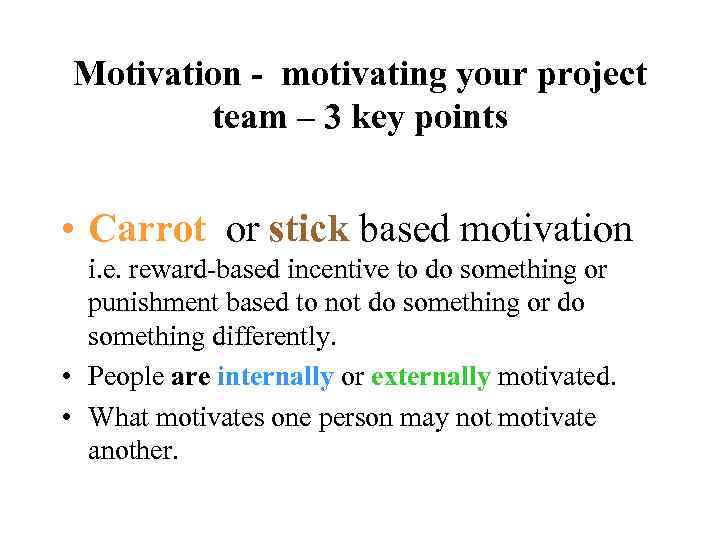
Motivation - motivating your project team – 3 key points • Carrot or stick based motivation i. e. reward-based incentive to do something or punishment based to not do something or do something differently. • People are internally or externally motivated. • What motivates one person may not motivate another.

Class exercise • How might you as project manager motivate members of a project team? • What steps/action could you take? • What assumptions have you made about your role/authority when making the above list?
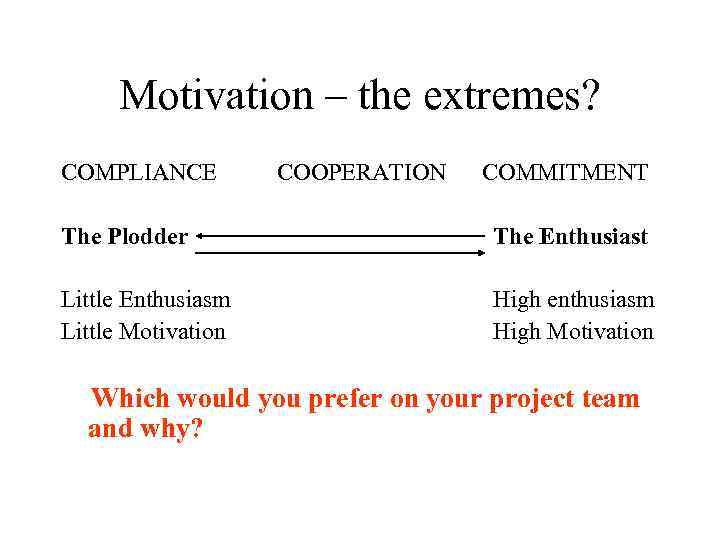
Motivation – the extremes? COMPLIANCE COOPERATION COMMITMENT The Plodder The Enthusiast Little Enthusiasm Little Motivation High enthusiasm High Motivation Which would you prefer on your project team and why?

Remember the old parable of the tortoise and the hare… • The slow plodder often gets there in the end • The enthusiast may get bored with implementation and routine run of the mill work; not stick with it and may lose initial enthusiasm
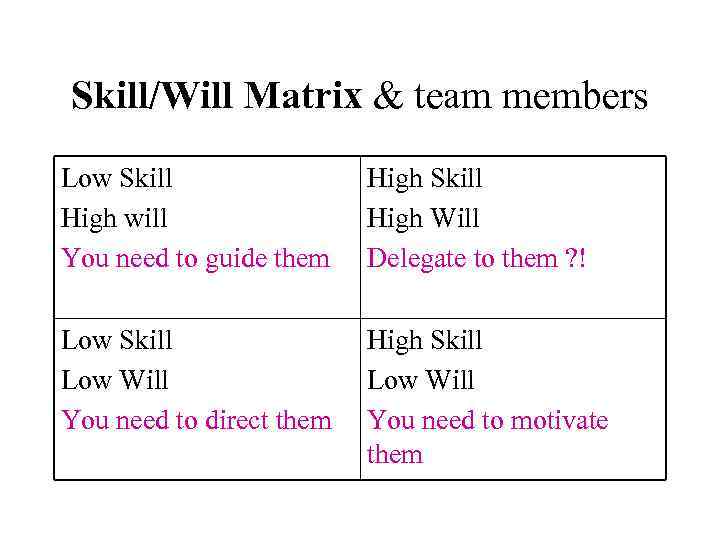
Skill/Will Matrix & team members Low Skill High will You need to guide them High Skill High Will Delegate to them ? ! Low Skill Low Will You need to direct them High Skill Low Will You need to motivate them

MOTIVATION Vroom’s Expectancy Theory • Vroom identifies human behaviour as being a function of two factors: 1 The perceived value of the reward that behaviour yields. 2 The expectation in the individual that certain behaviour actually will yield that reward.
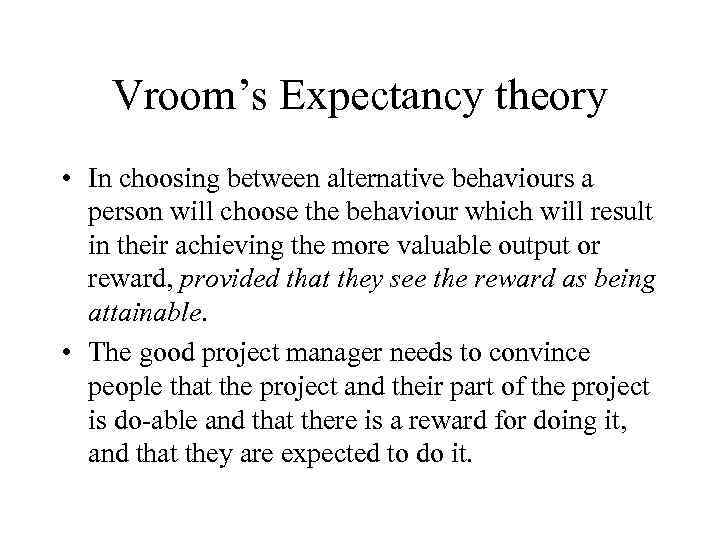
Vroom’s Expectancy theory • In choosing between alternative behaviours a person will choose the behaviour which will result in their achieving the more valuable output or reward, provided that they see the reward as being attainable. • The good project manager needs to convince people that the project and their part of the project is do-able and that there is a reward for doing it, and that they are expected to do it.

Using Vroom’s Expectancy theory to motivate a project team • To use theory to motivate staff you need to ensure that the desired performance will be rewarded and that the reward will be valued by the individual. • There are 5 steps to doing this
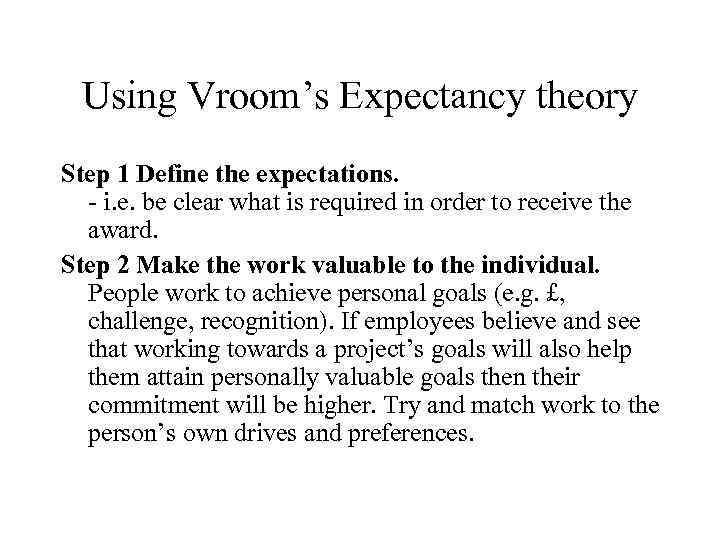
Using Vroom’s Expectancy theory Step 1 Define the expectations. - i. e. be clear what is required in order to receive the award. Step 2 Make the work valuable to the individual. People work to achieve personal goals (e. g. £, challenge, recognition). If employees believe and see that working towards a project’s goals will also help them attain personally valuable goals then their commitment will be higher. Try and match work to the person’s own drives and preferences.
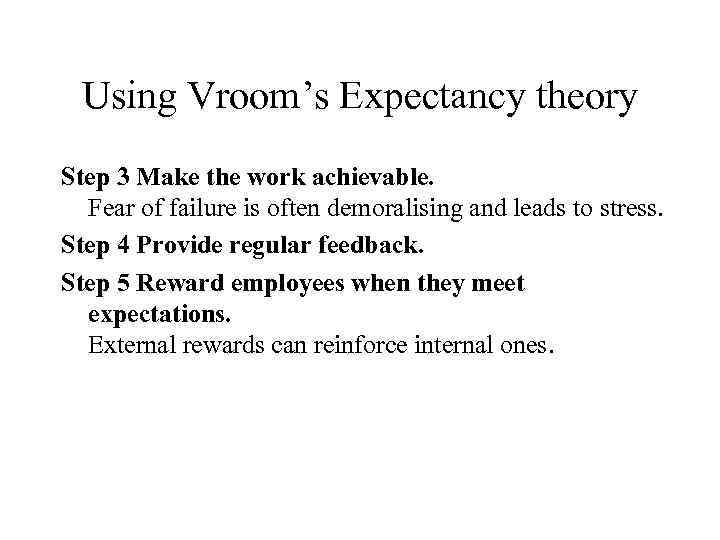
Using Vroom’s Expectancy theory Step 3 Make the work achievable. Fear of failure is often demoralising and leads to stress. Step 4 Provide regular feedback. Step 5 Reward employees when they meet expectations. External rewards can reinforce internal ones.
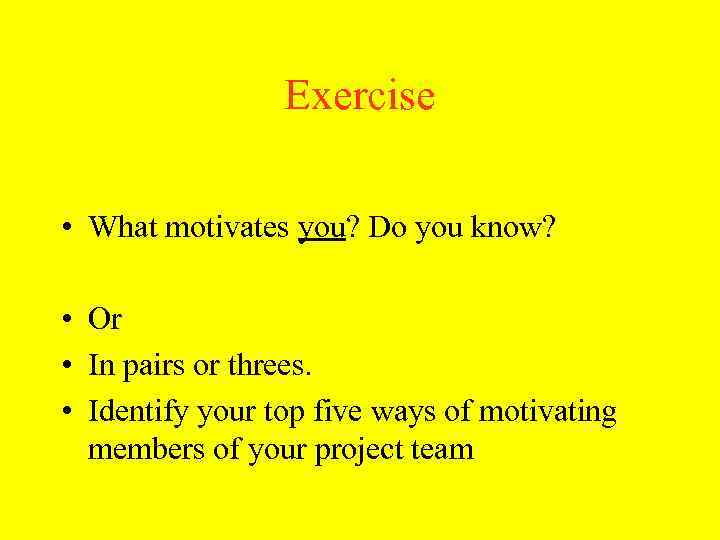
Exercise • What motivates you? Do you know? • Or • In pairs or threes. • Identify your top five ways of motivating members of your project team
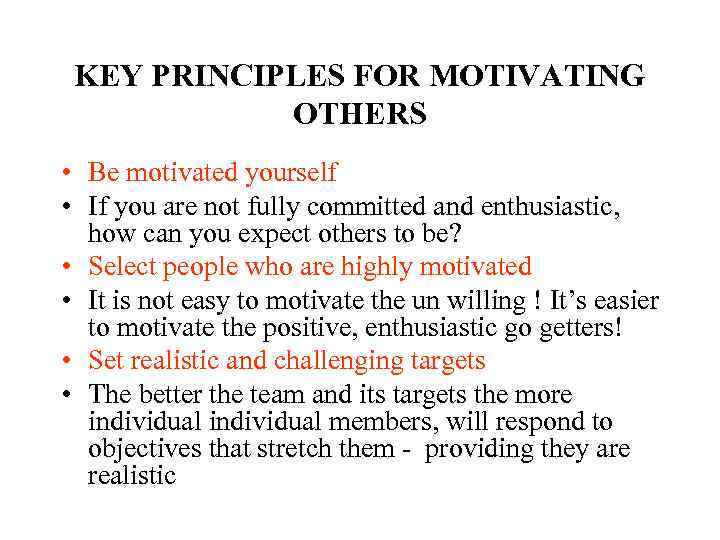
KEY PRINCIPLES FOR MOTIVATING OTHERS • Be motivated yourself • If you are not fully committed and enthusiastic, how can you expect others to be? • Select people who are highly motivated • It is not easy to motivate the un willing ! It’s easier to motivate the positive, enthusiastic go getters! • Set realistic and challenging targets • The better the team and its targets the more individual members, will respond to objectives that stretch them - providing they are realistic
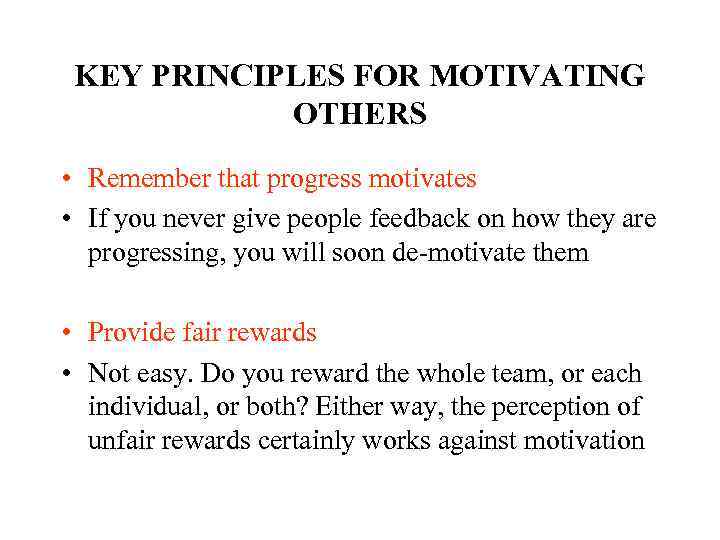
KEY PRINCIPLES FOR MOTIVATING OTHERS • Remember that progress motivates • If you never give people feedback on how they are progressing, you will soon de-motivate them • Provide fair rewards • Not easy. Do you reward the whole team, or each individual, or both? Either way, the perception of unfair rewards certainly works against motivation
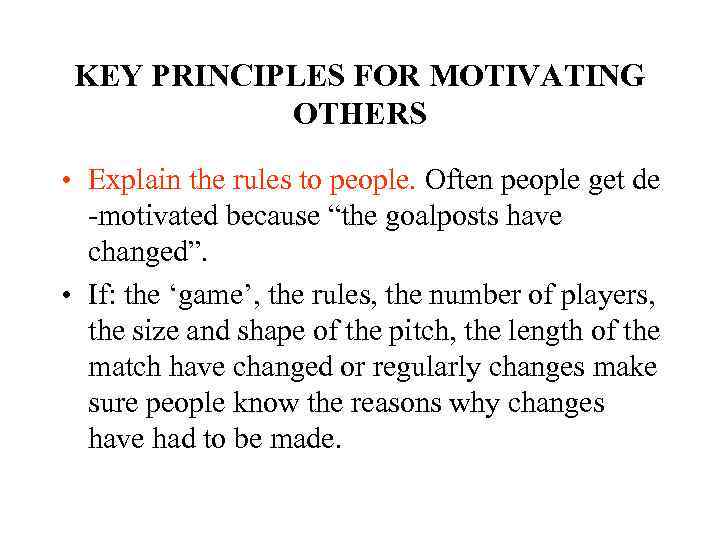
KEY PRINCIPLES FOR MOTIVATING OTHERS • Explain the rules to people. Often people get de -motivated because “the goalposts have changed”. • If: the ‘game’, the rules, the number of players, the size and shape of the pitch, the length of the match have changed or regularly changes make sure people know the reasons why changes have had to be made.
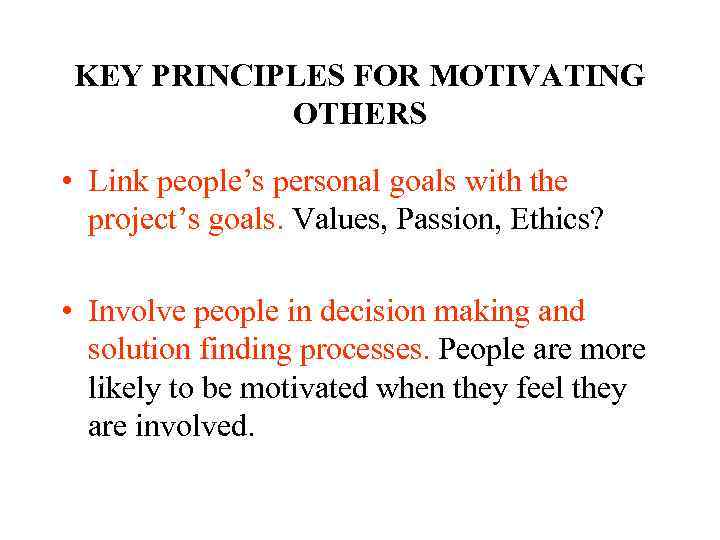
KEY PRINCIPLES FOR MOTIVATING OTHERS • Link people’s personal goals with the project’s goals. Values, Passion, Ethics? • Involve people in decision making and solution finding processes. People are more likely to be motivated when they feel they are involved.
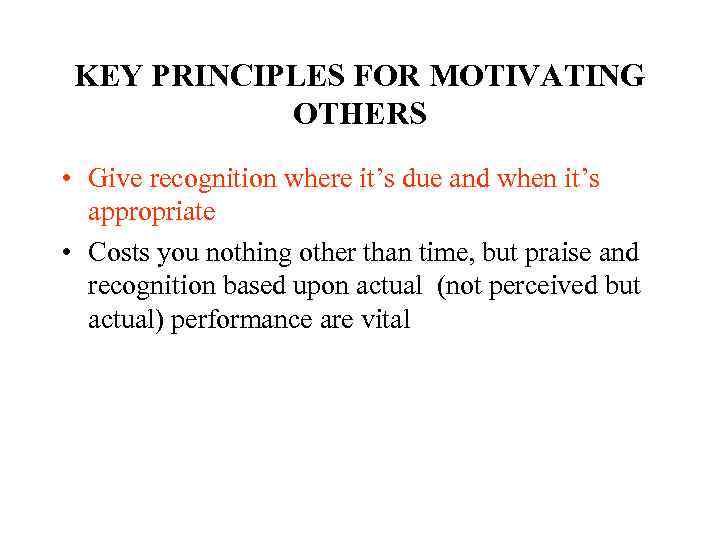
KEY PRINCIPLES FOR MOTIVATING OTHERS • Give recognition where it’s due and when it’s appropriate • Costs you nothing other than time, but praise and recognition based upon actual (not perceived but actual) performance are vital
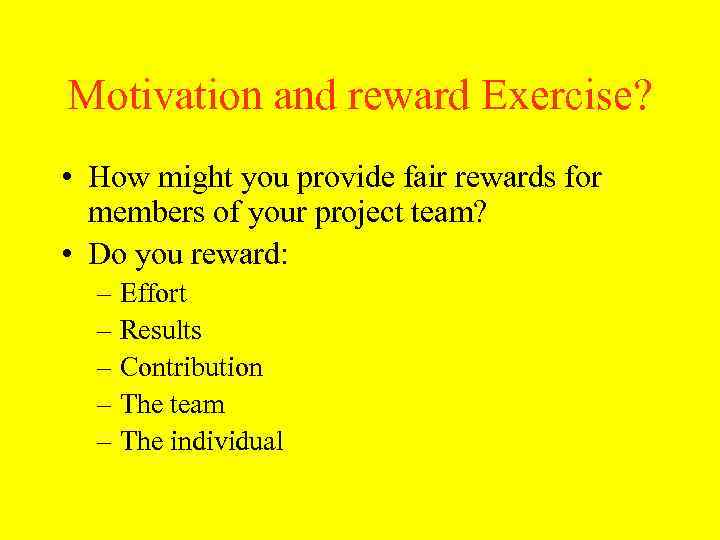
Motivation and reward Exercise? • How might you provide fair rewards for members of your project team? • Do you reward: – Effort – Results – Contribution – The team – The individual
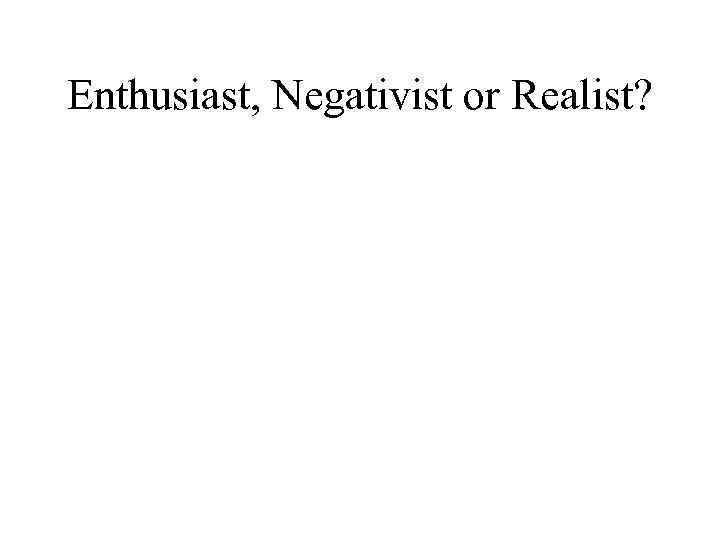
Enthusiast, Negativist or Realist?
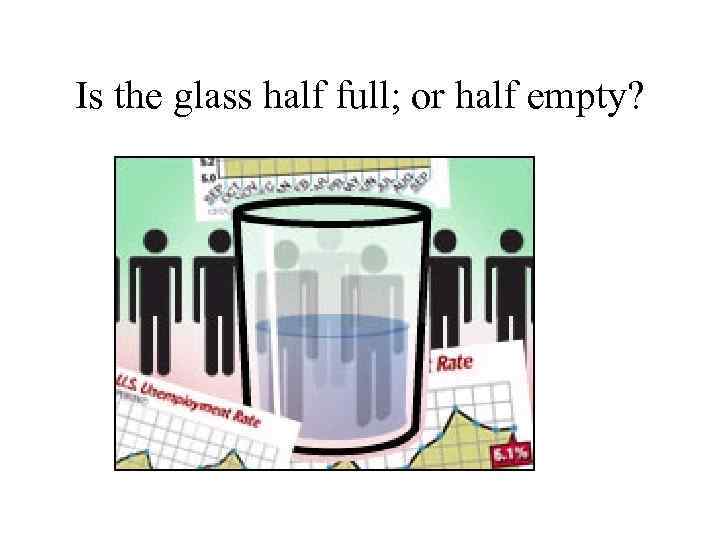
Is the glass half full; or half empty?
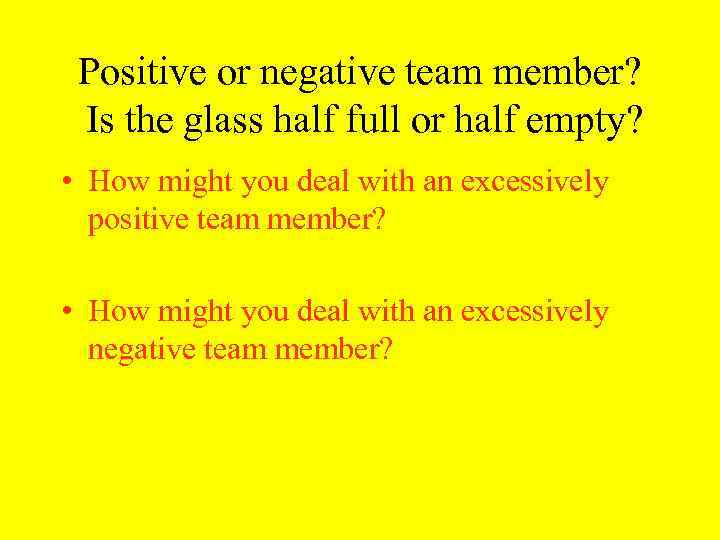
Positive or negative team member? Is the glass half full or half empty? • How might you deal with an excessively positive team member? • How might you deal with an excessively negative team member?
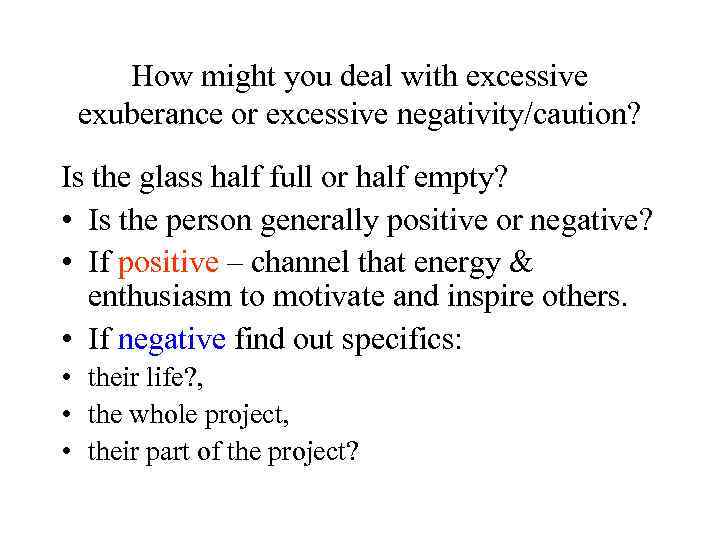
How might you deal with excessive exuberance or excessive negativity/caution? Is the glass half full or half empty? • Is the person generally positive or negative? • If positive – channel that energy & enthusiasm to motivate and inspire others. • If negative find out specifics: • their life? , • the whole project, • their part of the project?
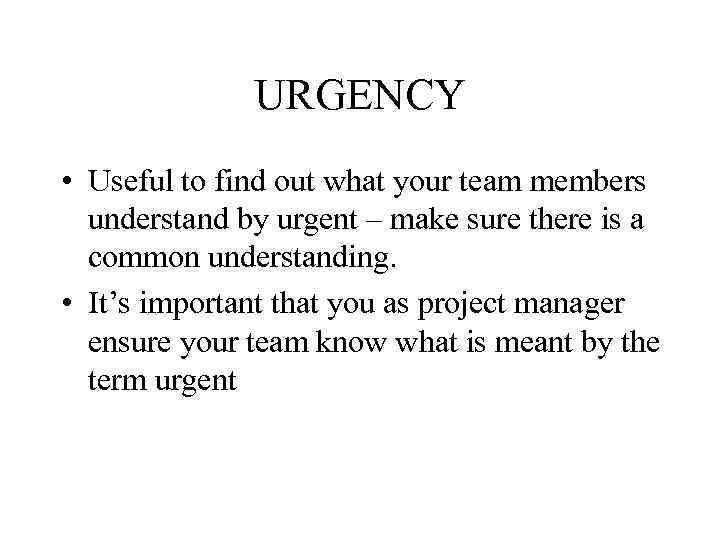
URGENCY • Useful to find out what your team members understand by urgent – make sure there is a common understanding. • It’s important that you as project manager ensure your team know what is meant by the term urgent
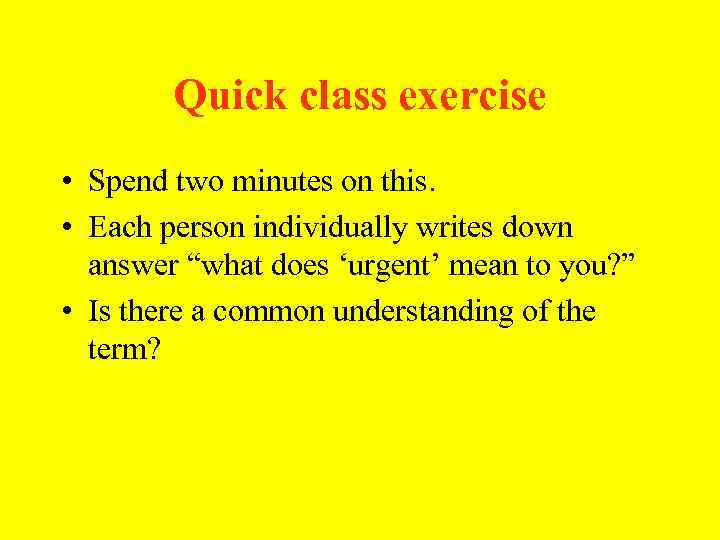
Quick class exercise • Spend two minutes on this. • Each person individually writes down answer “what does ‘urgent’ mean to you? ” • Is there a common understanding of the term?
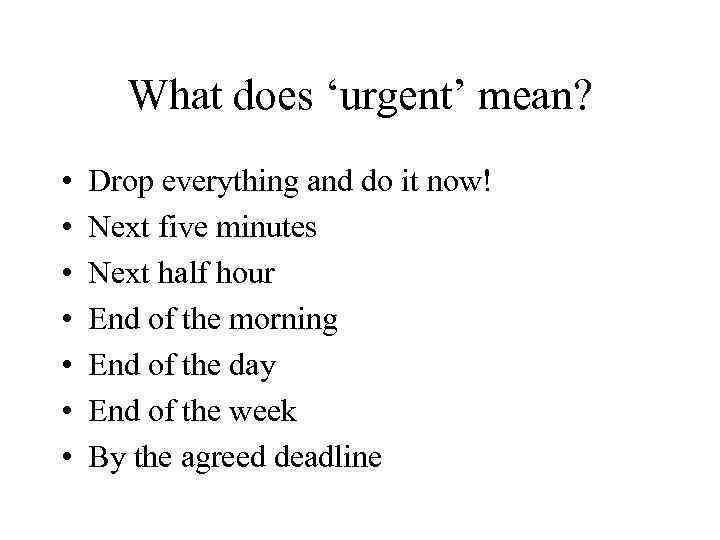
What does ‘urgent’ mean? • • Drop everything and do it now! Next five minutes Next half hour End of the morning End of the day End of the week By the agreed deadline
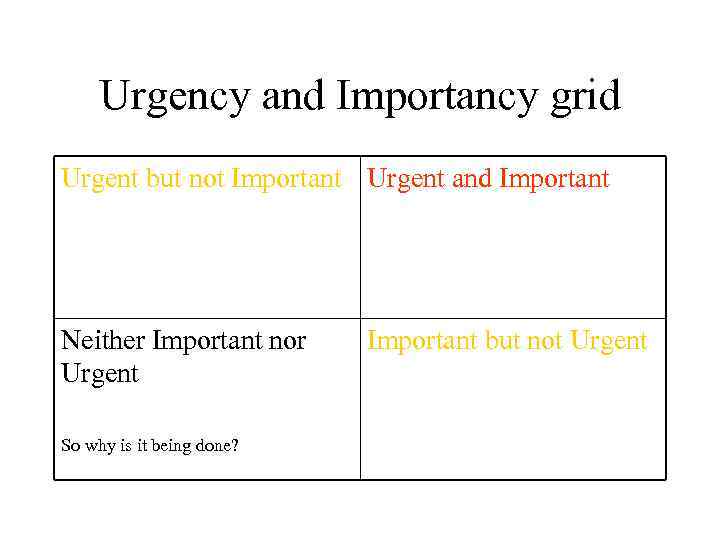
Urgency and Importancy grid Urgent but not Important Urgent and Important Neither Important nor Urgent So why is it being done? Important but not Urgent
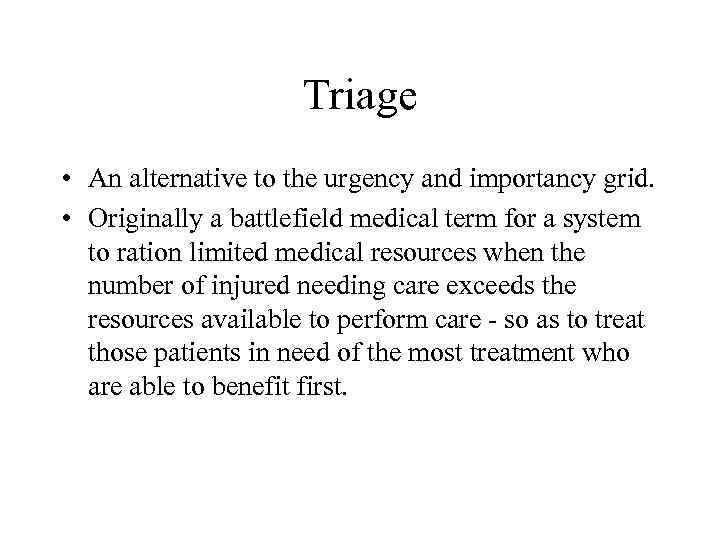
Triage • An alternative to the urgency and importancy grid. • Originally a battlefield medical term for a system to ration limited medical resources when the number of injured needing care exceeds the resources available to perform care - so as to treat those patients in need of the most treatment who are able to benefit first.
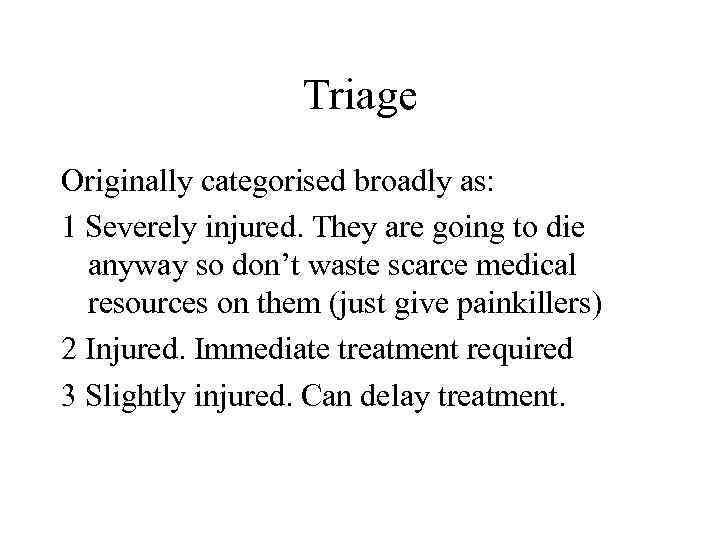
Triage Originally categorised broadly as: 1 Severely injured. They are going to die anyway so don’t waste scarce medical resources on them (just give painkillers) 2 Injured. Immediate treatment required 3 Slightly injured. Can delay treatment.
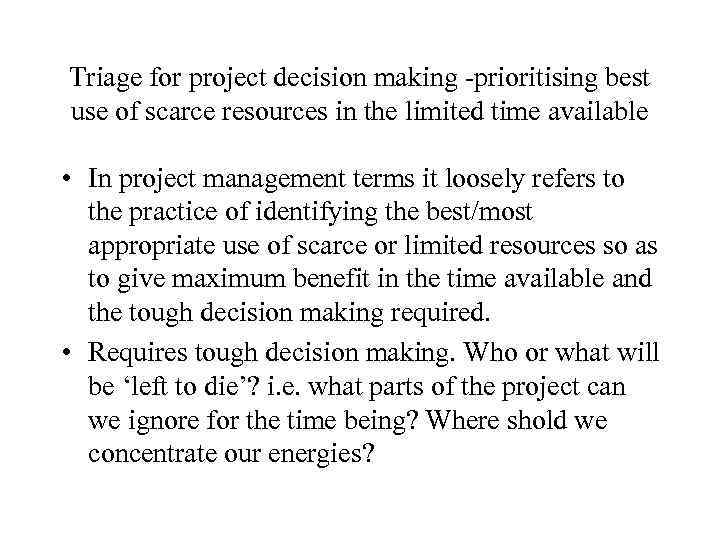
Triage for project decision making -prioritising best use of scarce resources in the limited time available • In project management terms it loosely refers to the practice of identifying the best/most appropriate use of scarce or limited resources so as to give maximum benefit in the time available and the tough decision making required. • Requires tough decision making. Who or what will be ‘left to die’? i. e. what parts of the project can we ignore for the time being? Where shold we concentrate our energies?
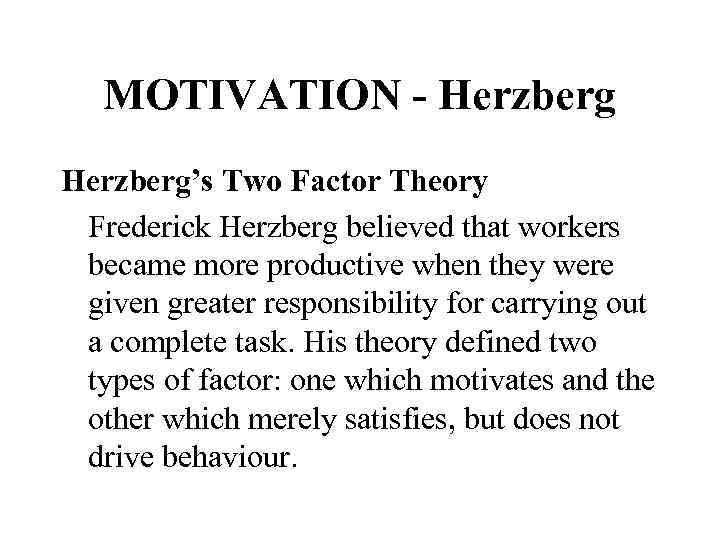
MOTIVATION - Herzberg’s Two Factor Theory Frederick Herzberg believed that workers became more productive when they were given greater responsibility for carrying out a complete task. His theory defined two types of factor: one which motivates and the other which merely satisfies, but does not drive behaviour.

MOTIVATION - Herzberg Motivating factors • • • Factors related to the job itself Achievement Responsibility Potential for growth The work itself
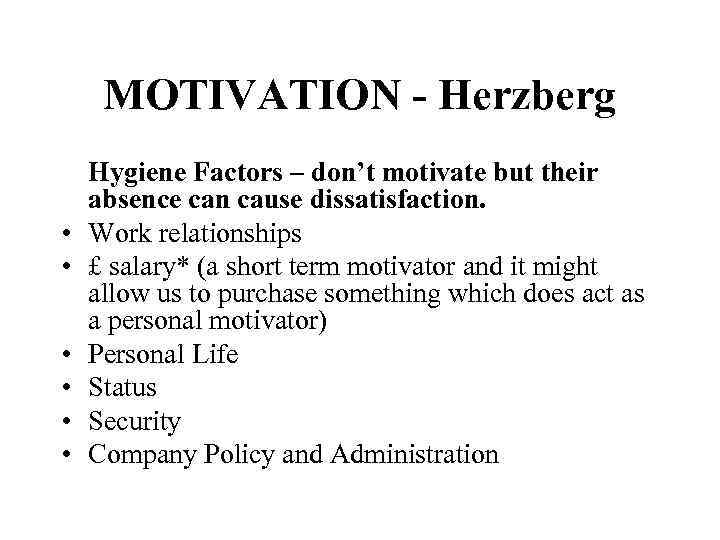
MOTIVATION - Herzberg • • • Hygiene Factors – don’t motivate but their absence can cause dissatisfaction. Work relationships £ salary* (a short term motivator and it might allow us to purchase something which does act as a personal motivator) Personal Life Status Security Company Policy and Administration
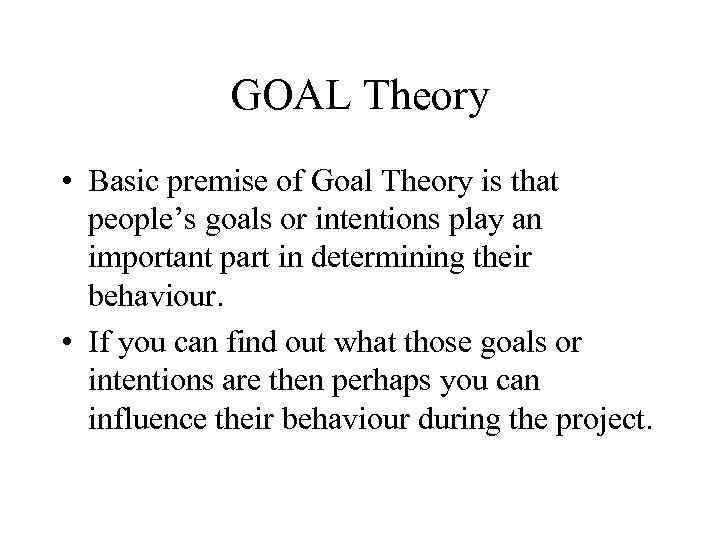
GOAL Theory • Basic premise of Goal Theory is that people’s goals or intentions play an important part in determining their behaviour. • If you can find out what those goals or intentions are then perhaps you can influence their behaviour during the project.
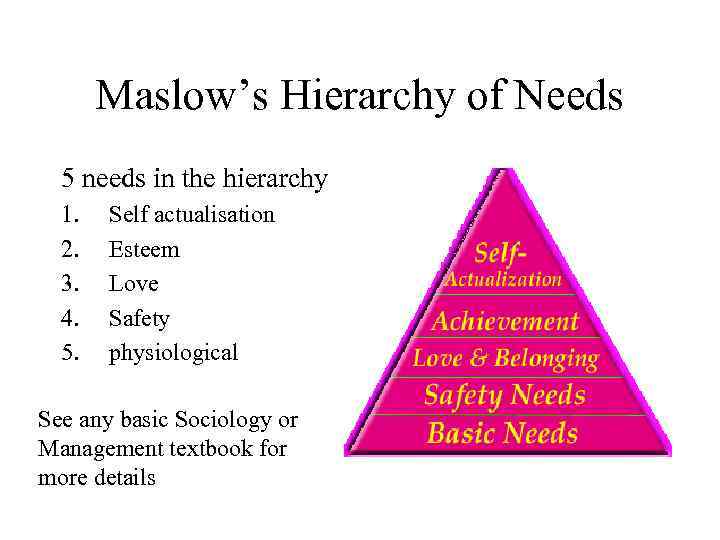
Maslow’s Hierarchy of Needs 5 needs in the hierarchy 1. 2. 3. 4. 5. Self actualisation Esteem Love Safety physiological See any basic Sociology or Management textbook for more details
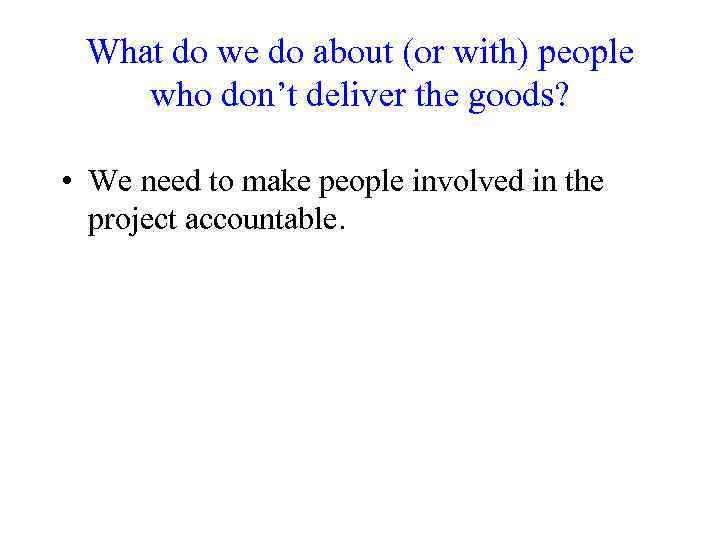
What do we do about (or with) people who don’t deliver the goods? • We need to make people involved in the project accountable.
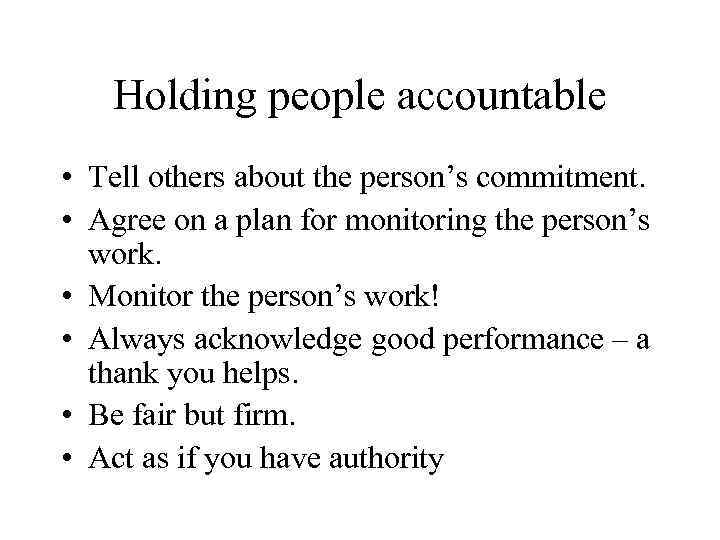
Holding people accountable • Tell others about the person’s commitment. • Agree on a plan for monitoring the person’s work. • Monitor the person’s work! • Always acknowledge good performance – a thank you helps. • Be fair but firm. • Act as if you have authority
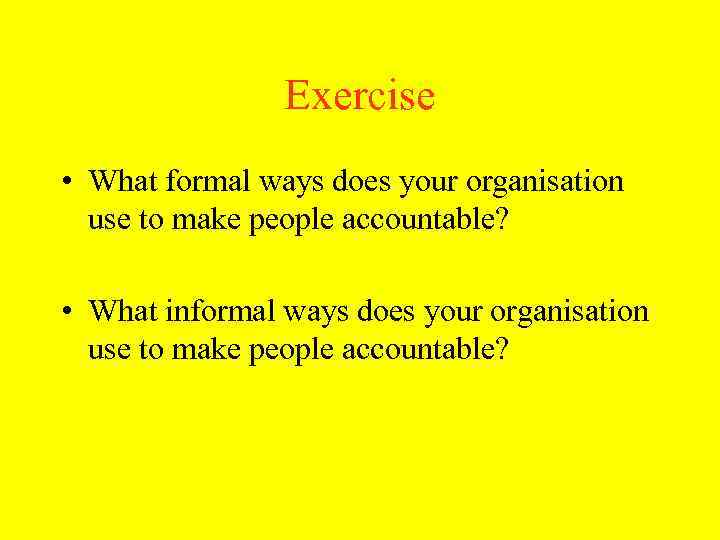
Exercise • What formal ways does your organisation use to make people accountable? • What informal ways does your organisation use to make people accountable?
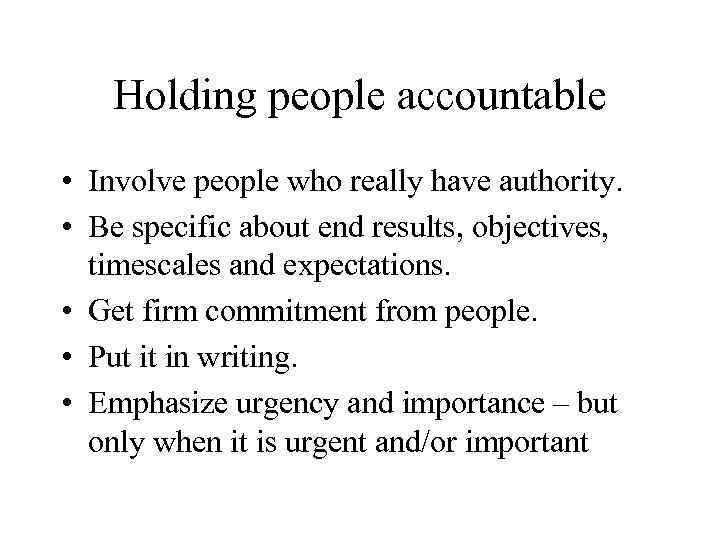
Holding people accountable • Involve people who really have authority. • Be specific about end results, objectives, timescales and expectations. • Get firm commitment from people. • Put it in writing. • Emphasize urgency and importance – but only when it is urgent and/or important
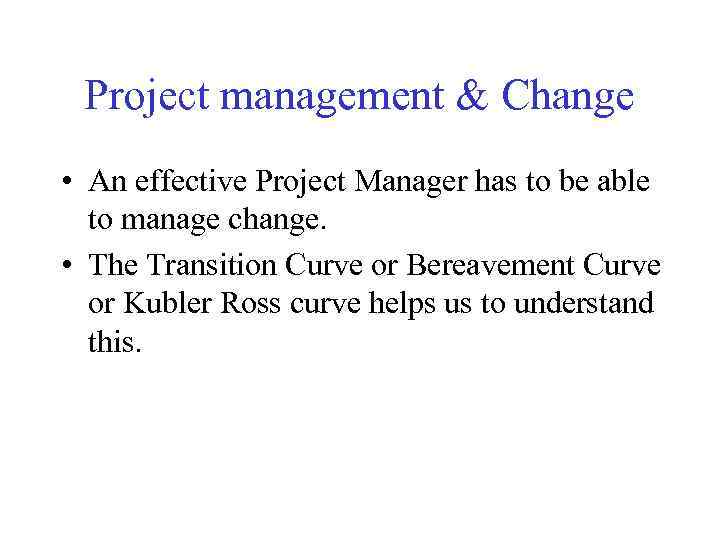
Project management & Change • An effective Project Manager has to be able to manage change. • The Transition Curve or Bereavement Curve or Kubler Ross curve helps us to understand this.
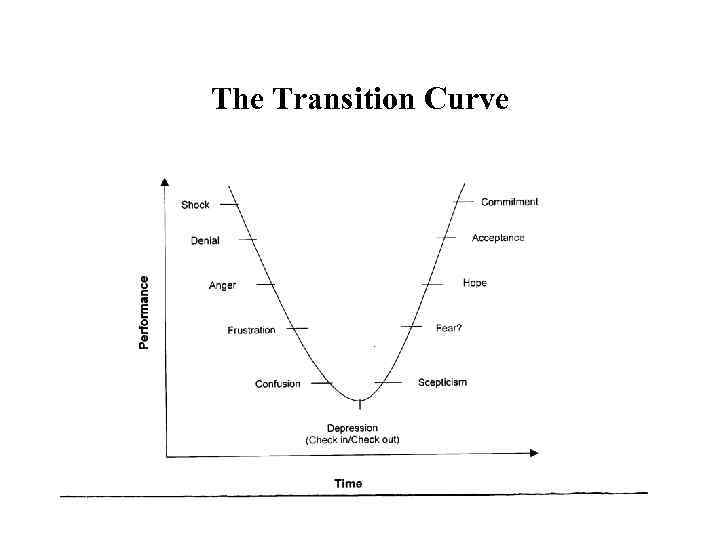
The Transition Curve
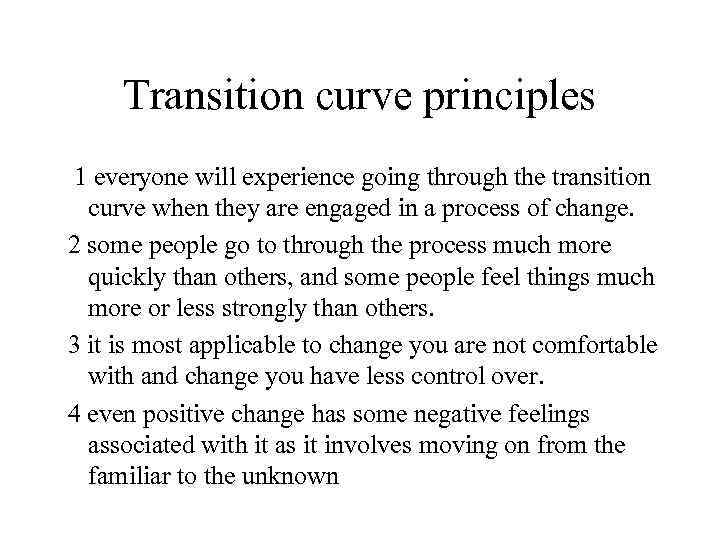
Transition curve principles 1 everyone will experience going through the transition curve when they are engaged in a process of change. 2 some people go to through the process much more quickly than others, and some people feel things much more or less strongly than others. 3 it is most applicable to change you are not comfortable with and change you have less control over. 4 even positive change has some negative feelings associated with it as it involves moving on from the familiar to the unknown
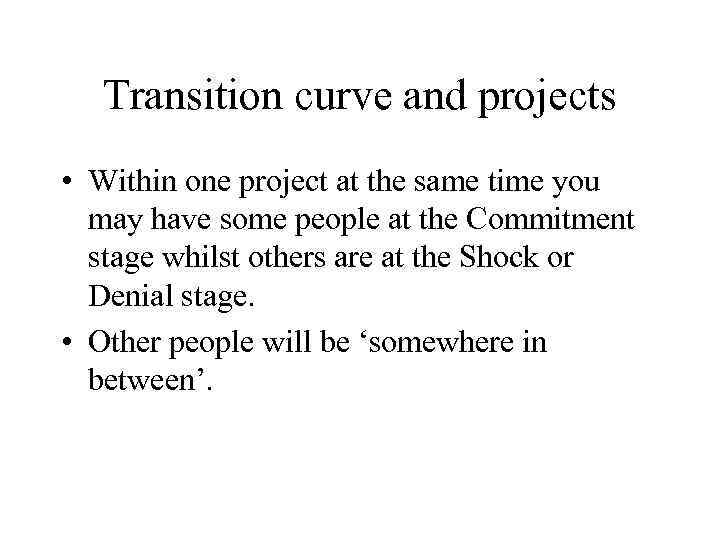
Transition curve and projects • Within one project at the same time you may have some people at the Commitment stage whilst others are at the Shock or Denial stage. • Other people will be ‘somewhere in between’.
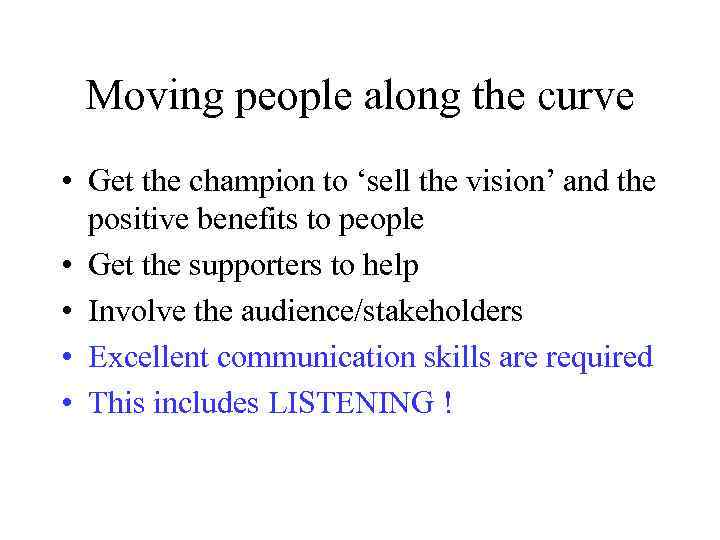
Moving people along the curve • Get the champion to ‘sell the vision’ and the positive benefits to people • Get the supporters to help • Involve the audience/stakeholders • Excellent communication skills are required • This includes LISTENING !
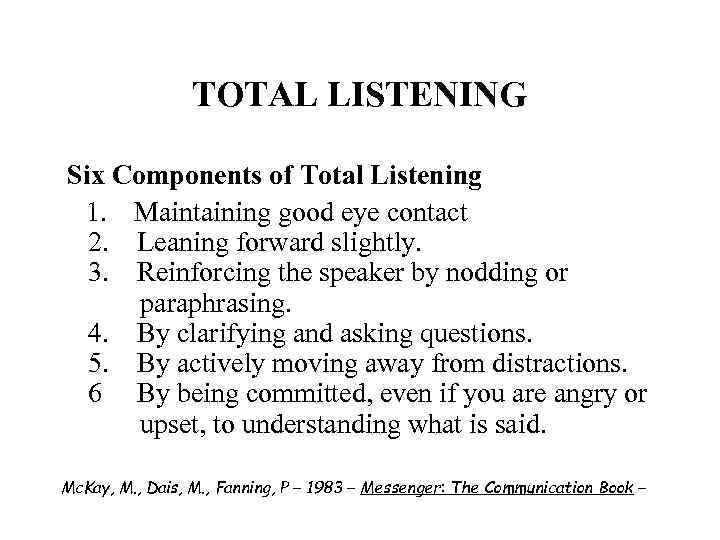
TOTAL LISTENING Six Components of Total Listening 1. Maintaining good eye contact 2. Leaning forward slightly. 3. Reinforcing the speaker by nodding or paraphrasing. 4. By clarifying and asking questions. 5. By actively moving away from distractions. 6 By being committed, even if you are angry or upset, to understanding what is said. Mc. Kay, M. , Dais, M. , Fanning, P – 1983 – Messenger: The Communication Book –
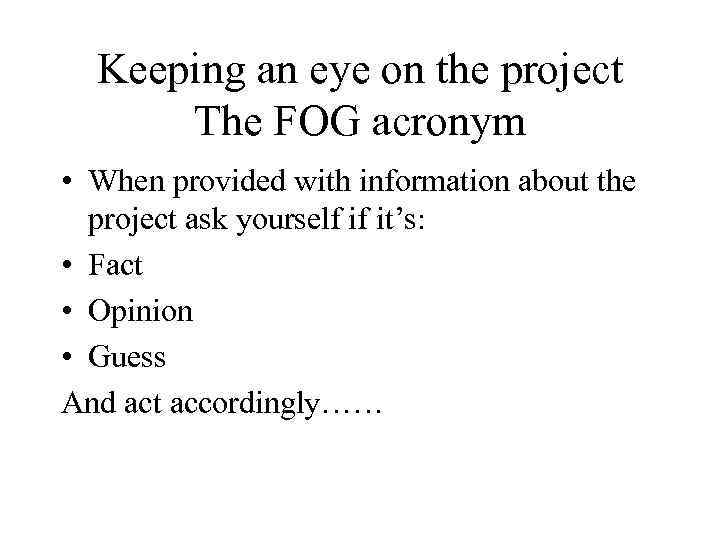
Keeping an eye on the project The FOG acronym • When provided with information about the project ask yourself if it’s: • Fact • Opinion • Guess And act accordingly……
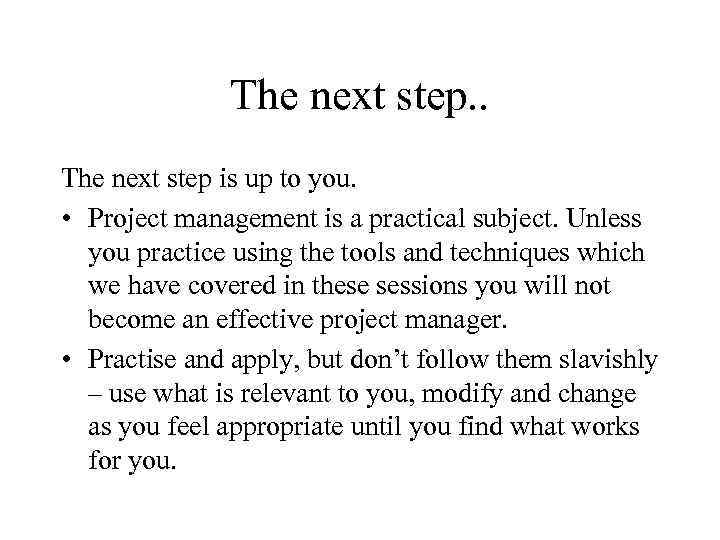
The next step. . The next step is up to you. • Project management is a practical subject. Unless you practice using the tools and techniques which we have covered in these sessions you will not become an effective project manager. • Practise and apply, but don’t follow them slavishly – use what is relevant to you, modify and change as you feel appropriate until you find what works for you.
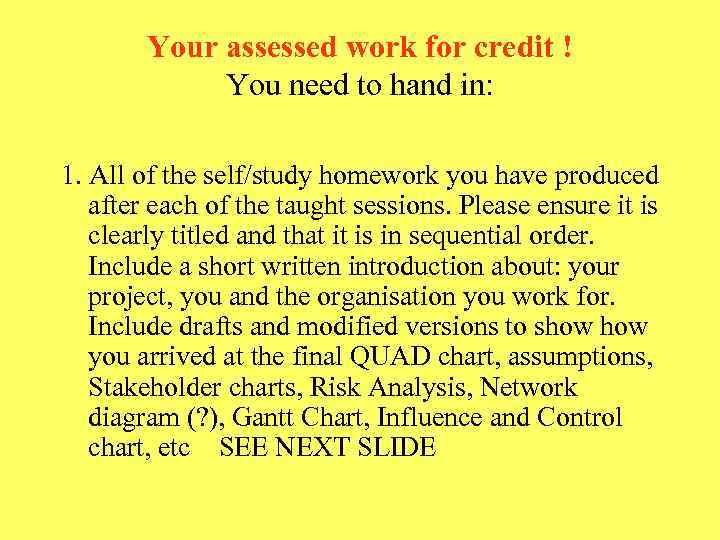
Your assessed work for credit ! You need to hand in: 1. All of the self/study homework you have produced after each of the taught sessions. Please ensure it is clearly titled and that it is in sequential order. Include a short written introduction about: your project, you and the organisation you work for. Include drafts and modified versions to show you arrived at the final QUAD chart, assumptions, Stakeholder charts, Risk Analysis, Network diagram (? ), Gantt Chart, Influence and Control chart, etc SEE NEXT SLIDE
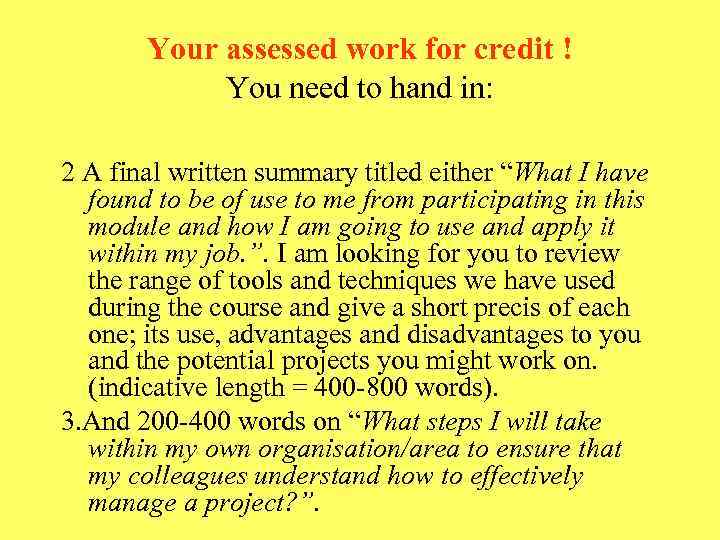
Your assessed work for credit ! You need to hand in: 2 A final written summary titled either “What I have found to be of use to me from participating in this module and how I am going to use and apply it within my job. ”. I am looking for you to review the range of tools and techniques we have used during the course and give a short precis of each one; its use, advantages and disadvantages to you and the potential projects you might work on. (indicative length = 400 -800 words). 3. And 200 -400 words on “What steps I will take within my own organisation/area to ensure that my colleagues understand how to effectively manage a project? ”.
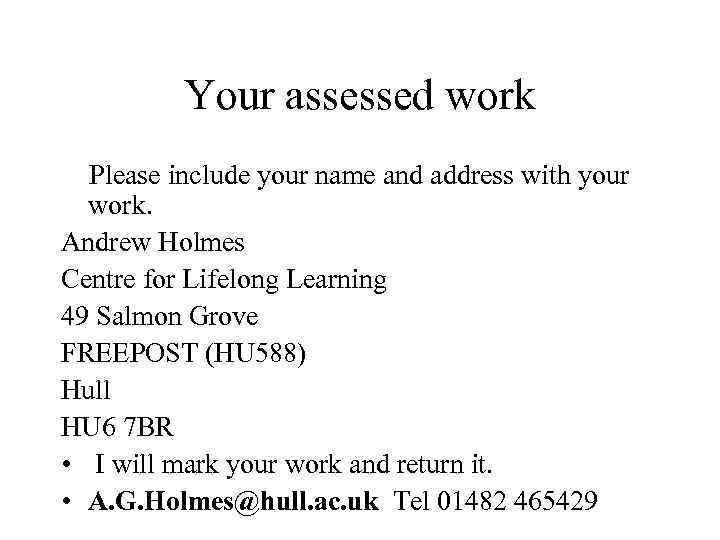
Your assessed work Please include your name and address with your work. Andrew Holmes Centre for Lifelong Learning 49 Salmon Grove FREEPOST (HU 588) Hull HU 6 7 BR • I will mark your work and return it. • A. G. Holmes@hull. ac. uk Tel 01482 465429
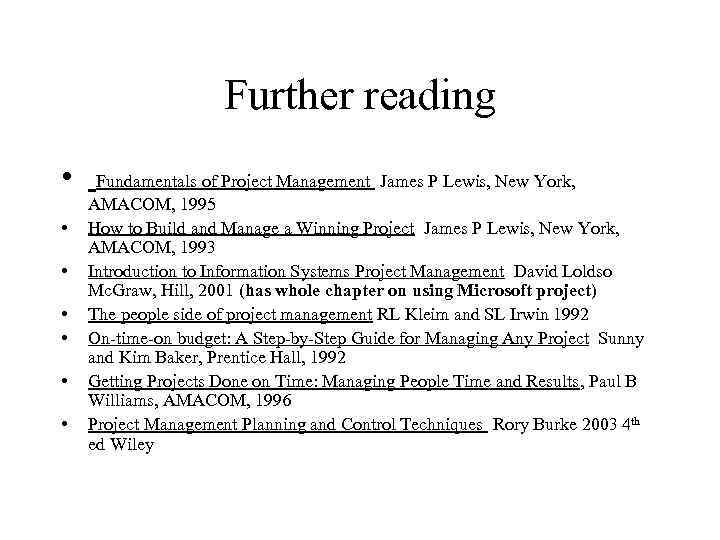
Further reading • Fundamentals of Project Management James P Lewis, New York, • • • AMACOM, 1995 How to Build and Manage a Winning Project James P Lewis, New York, AMACOM, 1993 Introduction to Information Systems Project Management David Loldso Mc. Graw, Hill, 2001 (has whole chapter on using Microsoft project) The people side of project management RL Kleim and SL Irwin 1992 On-time-on budget: A Step-by-Step Guide for Managing Any Project Sunny and Kim Baker, Prentice Hall, 1992 Getting Projects Done on Time: Managing People Time and Results, Paul B Williams, AMACOM, 1996 Project Management Planning and Control Techniques Rory Burke 2003 4 th ed Wiley
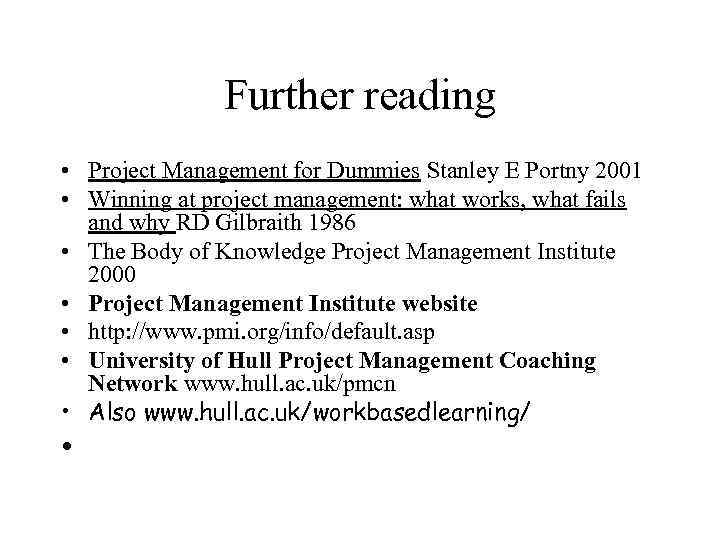
Further reading • Project Management for Dummies Stanley E Portny 2001 • Winning at project management: what works, what fails and why RD Gilbraith 1986 • The Body of Knowledge Project Management Institute 2000 • Project Management Institute website • http: //www. pmi. org/info/default. asp • University of Hull Project Management Coaching Network www. hull. ac. uk/pmcn • Also www. hull. ac. uk/workbasedlearning/ •
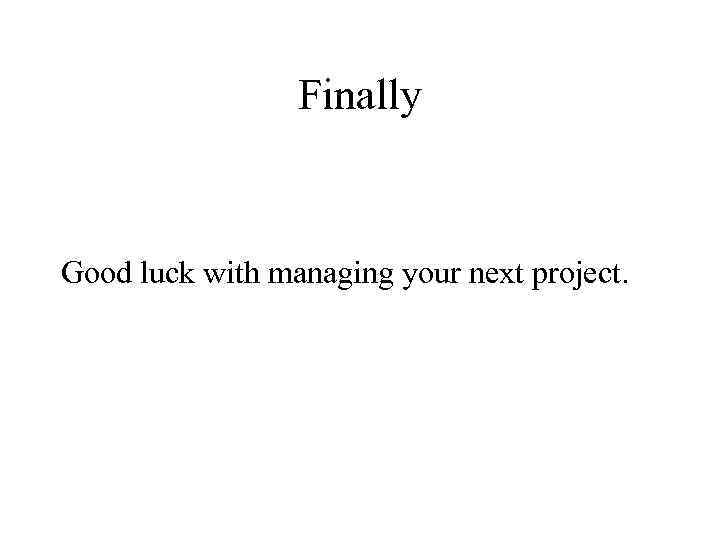
Finally Good luck with managing your next project.
Methodology of PM.ppt